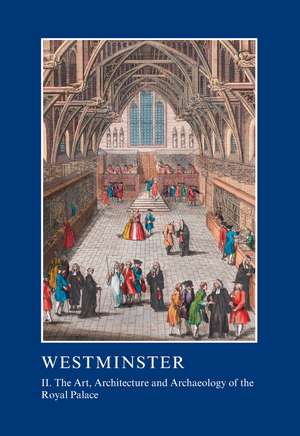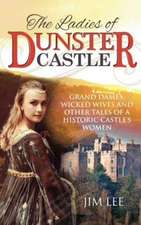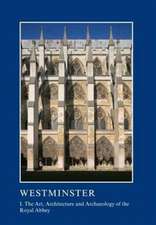Westminster Part II: The Art, Architecture and Archaeology of the Royal Palace: The British Archaeological Association Conference Transactions
Editat de Warwick Rodwell, Tim Tatton-Brownen Limba Engleză Hardback – 31 aug 2016
Part I begins with studies of the topography of the area, an account of its Roman-period finds and an historiographical overview of the archaeology of the Abbey. Edward the Confessor’s enigmatic church plan is discussed and the evidence for later Romanesque structures is assembled for the first time. Five papers examine aspects of Henry III’s vast new Abbey church and its decoration. A further four cover aspects of the later medieval period, coronation, and Sir George Gilbert Scott’s impact as the Abbey’s greatest Surveyor of the Fabric. A pair of papers examines the development of the northern precinct of the Abbey, around St Margaret’s Church, and the remarkable buildings of Westminster School, created within the remains of the monastery in the 17th and 18th centuries.
Part II part deals with the Palace of Westminster and its wider topography between the late 11th century and the devastating fire of 1834 that largely destroyed the medieval palace. William Rufus’s enormous hall and its famous roofs are completely reassessed, and comparisons discussed between this structure and the great hall at Caen. Other essays reconsider Henry III’s palace, St Stephen’s chapel, the king’s great chamber (the ‘Painted Chamber’) and the enigmatic Jewel Tower. The final papers examine the meeting places of Parliament and the living accommodation of the MPs who attended it, the topography of the Palace between the Reformation and the fire of 1834, and the building of the New Palace which is better known today as the Houses of Parliament.
Din seria The British Archaeological Association Conference Transactions
-
 Preț: 282.31 lei
Preț: 282.31 lei - 9%
 Preț: 941.15 lei
Preț: 941.15 lei -
 Preț: 302.63 lei
Preț: 302.63 lei -
 Preț: 314.64 lei
Preț: 314.64 lei - 22%
 Preț: 326.69 lei
Preț: 326.69 lei - 11%
 Preț: 391.41 lei
Preț: 391.41 lei - 15%
 Preț: 270.25 lei
Preț: 270.25 lei - 25%
 Preț: 852.22 lei
Preț: 852.22 lei - 11%
 Preț: 346.04 lei
Preț: 346.04 lei - 16%
 Preț: 244.53 lei
Preț: 244.53 lei - 12%
 Preț: 299.52 lei
Preț: 299.52 lei - 12%
 Preț: 303.64 lei
Preț: 303.64 lei - 17%
 Preț: 245.92 lei
Preț: 245.92 lei - 15%
 Preț: 253.62 lei
Preț: 253.62 lei - 12%
 Preț: 342.58 lei
Preț: 342.58 lei - 25%
 Preț: 782.13 lei
Preț: 782.13 lei - 25%
 Preț: 768.69 lei
Preț: 768.69 lei - 16%
 Preț: 252.40 lei
Preț: 252.40 lei -
 Preț: 289.37 lei
Preț: 289.37 lei - 12%
 Preț: 339.76 lei
Preț: 339.76 lei - 11%
 Preț: 346.01 lei
Preț: 346.01 lei - 16%
 Preț: 262.96 lei
Preț: 262.96 lei - 16%
 Preț: 249.24 lei
Preț: 249.24 lei - 25%
 Preț: 500.22 lei
Preț: 500.22 lei - 25%
 Preț: 487.01 lei
Preț: 487.01 lei - 17%
 Preț: 238.85 lei
Preț: 238.85 lei - 13%
 Preț: 298.10 lei
Preț: 298.10 lei - 25%
 Preț: 738.30 lei
Preț: 738.30 lei - 22%
 Preț: 485.50 lei
Preț: 485.50 lei - 9%
 Preț: 322.47 lei
Preț: 322.47 lei - 25%
 Preț: 740.82 lei
Preț: 740.82 lei - 25%
 Preț: 782.13 lei
Preț: 782.13 lei - 26%
 Preț: 765.84 lei
Preț: 765.84 lei
Preț: 770.74 lei
Preț vechi: 1031.25 lei
-25% Nou
Puncte Express: 1156
Preț estimativ în valută:
147.49€ • 153.06$ • 123.28£
147.49€ • 153.06$ • 123.28£
Carte tipărită la comandă
Livrare economică 17-31 martie
Preluare comenzi: 021 569.72.76
Specificații
ISBN-13: 9781910887271
ISBN-10: 1910887277
Pagini: 280
Dimensiuni: 174 x 246 x 24 mm
Greutate: 0.82 kg
Ediția:1
Editura: Taylor & Francis
Colecția Routledge
Seria The British Archaeological Association Conference Transactions
Locul publicării:Oxford, United Kingdom
ISBN-10: 1910887277
Pagini: 280
Dimensiuni: 174 x 246 x 24 mm
Greutate: 0.82 kg
Ediția:1
Editura: Taylor & Francis
Colecția Routledge
Seria The British Archaeological Association Conference Transactions
Locul publicării:Oxford, United Kingdom
Cuprins
List of Abbreviations -- Preface -- An Introduction to the Topography of the Medieval Palace of Westminster/john crook -- Romanesque Westminster Hall and its Roof/roland b. harris and daniel miles with an appendix by thomas hill -- The Great Hall at Caen and its Affi nities with Westminster/edward impey -- Henry III’s Palace at Westminster/virginia jansen -- St Stephen’s Chapel, Westminster/john goodall -- Late-14th-Century Reconstruction of Westminster Hall/julian munby -- Parliaments, MPs and the Buildings of Westminster in the Middle Ages/david harrison -- A Monument to St Edward the Confessor: Henry III’s Great Chamber at Westminster and its Paintings/christopher wilson -- ‘The New Tower at the End of the King’s Garden’: The Jewel Tower and the Royal Treasure/jeremy ashbee with an appendix by paul everson -- The Topography of the Old Palace of We stminster, 1510–1834/mark collins -- The New Palace of Westminster/steven brindle.
Notă biografică
Warwick Rodwell, Tim Tatton-Brown
Descriere
Westminster came into existence in the later Anglo-Saxon period, and by the mid-11th century it was a major royal centre. This series of twenty-eight papers covers new research on the topography, buildings, art-history, architecture and archaeology of Westminster’s two great establishments — Abbey and Palace








